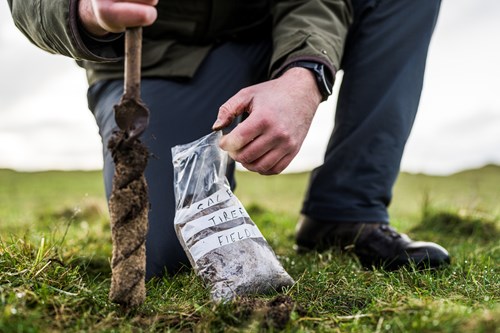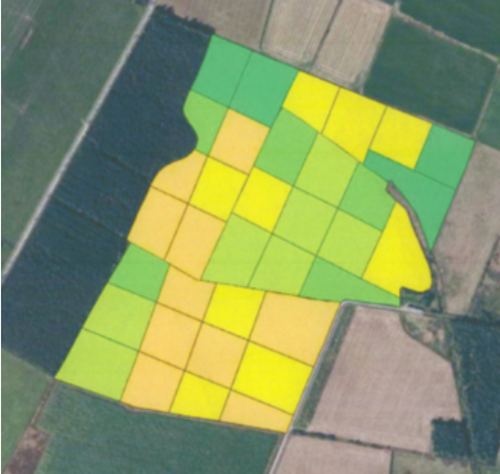Soil Sampling: Know More, Grow More

Soil sampling is a simple and easy tool that provides valuable information about soil including pH and nutrient levels. Soil sampling helps farmers and crofters to make better informed decisions on the type and quantity of fertiliser or manures required to reach target levels for optimum crop production. This allows better planning of nutrient applications to the soil, avoiding over or under application of particular nutrients, ultimately leading to better crops, improved efficiency and reduced environmental impact.
How to Soil Sample
When soil sampling, the most effective tools are a soil auger or corer. While soil sampling can be collected at any time of the year, it’s important to avoid sampling within two years of lime application or within two months of applying fertiliser, organic manure or more than 50kg/ha of nitrogen (40 units/acre).
To achieve a reliable result while sampling, walk across the field in a ‘W’ pattern and collect around 25 cores to ensure the sample is truly representative. Sampling depth depends on how the land is used: for arable fields and temporary grass, a depth of about 20cm is required while for permanent grassland, 10cm is enough – in both instances taking care to avoid including surface vegetation in the sample.
The frequency of sampling should be tailored to the individual farm or croft. Establishing a sampling rotation that aligns with current farming practices will enhance the efficiency of the fertiliser application and the effectiveness of crop rotation. Ideally, soil samples should be collected every three to five years from the same field at the same stage in the rotation, this could be closely following the harvesting of the previous crop or well in advance of planting any sensitive crops.
What to Test For
Soil analyses that are typically requested for routine soil samples are:
- pH and lime requirement.
- Extractable phosphorous, potassium and magnesium quoted in milligrams/litre - this quotes the amount of each nutrient available to be used by the plant.
There are a wide range of other tests available including heavy metals and trace elements as well as soil texture and organic matter.
GPS Soil Sampling
While sampling can be done manually the option for GPS sampling technology is also available. This process divides fields into a grid system with each section equating to 0.25 ha as seen in Figure 1. GPS soil mapping identifies the variability within a field, allowing inputs to be applied in a more precise way. GPS sampling usually focuses on the pH, phosphorus, and potassium levels, offering precise, location-specific nutrient data, in comparison to manually sampling which can provide a broader range of data. This can then lead to targeted applications of lime and fertiliser, if required.

Figure 1: GPS soil mapping
Whole Farm Plan Requirements and Soil Sampling
Soil sampling to test the chemical composition and nutrient content of the soil is one of the five components of the Whole Farm Plan (WFP). For a soil sample to be eligible, as a minimum, the tests conducted must include pH level, phosphate (P) and potash (K).
From 2026 onwards, soil samples must include soil carbon in addition to pH, P and K. This upcoming change reflects the increasing emphasis on soil health and carbon management as part of sustainable farming practices.
For more information on Whole Farm Plan requirements and soil sampling visit fas.scot.
Preparing for Sustainable Farming (PSF) and Soil Sampling
Under the Preparing for Sustainable Farming (PSF) grant, there is support available for completing soil sampling. The PSF scheme provides grant funding for soil sampling 20% of your region 1 land. However, to be eligible to apply for this funding a carbon audit must have been completed within the previous three years.
This is the final year of PSF funding. If you are considering soil sampling and looking to claim under PSF you must complete the sampling by 31 December 2025. For more information of PSF funding (funding is also available for completing a carbon audit) visit ruralpayments.org.
Ultimately, completing soil sampling not only equips farmers and crofters with a clearer understanding of their soil nutrient make up but also enables them to reduce carbon emissions, enhance fertiliser efficiency, use their land more effectively and strengthen the financial sustainability of their business – all with the added benefit of being able to receive funding towards the completion of these practices.
5 Top Tips
- Establish a regular soil sampling rotation.
- Soil sampling and analysis allows for more efficient fertiliser application.
- Ensuring a correct soil pH is the most important aspect of soil analysis.
- Use PSF funding while the funding is still available.
- Soil sampling soil is one of the five components of the WFP.
Useful Links
- www.fas.scot/downloads/practical-guide-soil-sampling-ii-benefits-business
- www.sruc.ac.uk/media/4qgfjtuh/valuing-your-soils.pdf
- www.sruc.ac.uk/media/jwfa0igj/healthy-grassland-soils-pocketbook.pdf
Ellie Newlands, Consultant, Ellie.Newlands@sac.co.uk

Unearthed is the exclusive SAC Consulting members' monthly newsletter. Unearthed offers insights and tips from our experts on what we think is in store for farming and crofting in the coming months in order to protect and enhance your business.
Posted by Unearthed News on 16/07/2025
